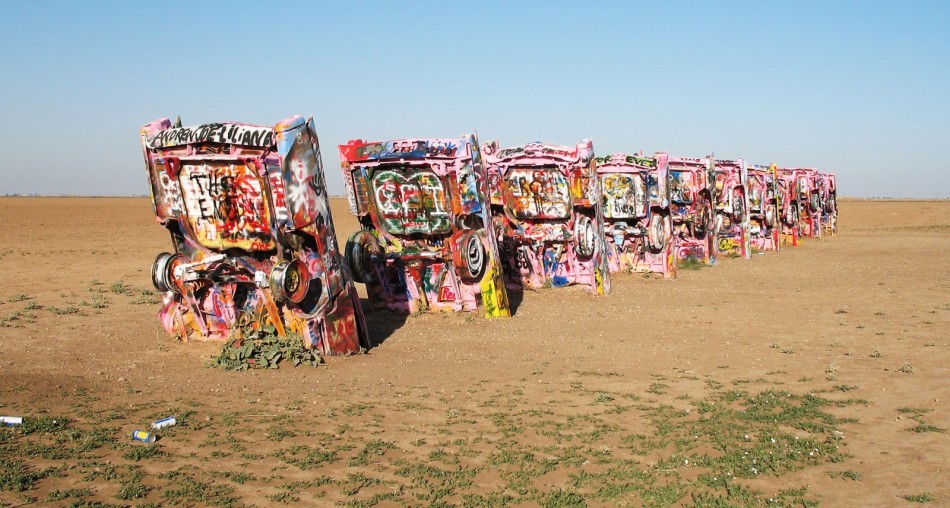
Video still from Ant Farm's Media Burn, 1975
Rediscovering Ant Farm’s Media Van: The ISEA2012 Blog
Loading up on the 7:13 am train last Monday to get to the KiMo Theater in time for Chip Lord’s Ant Farm session (on the last day of the ISEA2012 conference in Albuquerque) I began to muse about the “transportation” theme, during the train ride. Trains have always been my favorite form of transportation. This particular track affords a close brush with the topology of La Bajada. Views of thin cows and thinner horses. Graffiti of bumblebees and robots: Murals on rail corridors. The old trading post at Santo Domingo. Garbage. Eco-housing consisting of a double-decker stacked aluminum trailer. A “model home” near Bernalillo on which all work has stopped (interesting what this does to a perception of time in architecture). Culminating in sitting in a theater seat time-traveling to past times when art was very very engaged with media, in ways that seem terrifically pertinent now.
Chip Lord of Ant Farm was first on stage (after intros by Andrea Polli and by Greg Esser of the Desert Initiative based at ASU. At ASU Art Museum, a show that runs through December 1, presents the Ant Farm Media Van v.08 [Time Capsule] “by the legendary art and technology cooperative Ant Farm, active from 1968 to 1978.”)

Cadillac Ranch, Amarillo
For any not quite old enough, the “legendary cooperative” remains indelibly associated with the 1974 installation, Cadillac Ranch, at Stanley Marsh’s ranch in Amarillo, Texas – a project that occurred not too long after Robert Smithson’s death in a plane crash, and that, according to Chip Lord, got instigated between himself, Doug Michels and Marsh, by exchanges of mail art.
A quick segue in Lord’s talk introduced the hilarious and memorable 1975 event called Media Burn which came from “the idea, let’s create an image of a car crashing through a pyramid of TV sets.” (featured image, above). The event by “two media matadors” (a phrase actor Doug Hall used in the speech he delivered as John F. Kennedy) was commentary against the monopoly of the broadcasting networks ABC, CBS and NBC. But like everything Ant Farm did, the creation of the car-airplane-crashing the pyramid was also inspired by their being architects, constructors of the new world order as laid out in Stewart Brand’s Whole Earth Catalog.
By 1965-66 when McLuhan made “the media is the message” utterance, Lord and Michels were already interested in media, and had indeed already devised v.01 of the “Media Van”: vehicle as a total documentation tool, performative as well as documentary, “an elaborate feedback and surveillance device” equipped with the second version of the Sony PortaPak, with which you could record video and create alternative TV.
The coop devised a “truckstop network” for the van’s travels — an early form of localized social networking that would offer a mobile convoy of citizens who would stop at the network, interconnected “nodes” of services such as available at RV parks (water-sewage disposal-electricity), but also DIY instruction in photography, video, information access and so on. The radicalism of the idea was revisited in 2007 when SFMOMA curator Rudolf Freilich invited them to add a new version of Media Van to SFMOMA’s exhibit, The Art of Participation 1950-Now. The invitation, per Chip Lord, induced the question of “how to make a version of the Media Van in ’07 that would be true to the original in spirit?”
Hilarity equal to that of the Media Burn ensued. The artists paid $250 for a 1972 Chevy van precisely like the original v.01 and set about “rediscovering” the van — a narrative of its retrieval from storage in a nike missile silo. The documentation aspect included the return to light of the 1972 v.01, removal of any association with the oil economy, and incorporation of the steering wheel into a media huqquh (hookah), whereby plugging in your handheld device would result in the media van’s downloading a picture or music file from you, then spitting out a receipt for your participation that included a discount at the museum store (!).
In spirit adept — and accurate to the way the first media van incited ideas of public time capsules, Media Van v.08 at ASU now introduces the HUQQUH to the Arizona and visiting public, who will through their personal donations be making a new “digital time capsule of images and music … through the process of plugging in a personal digital device such as a camera, MP3 player or Smartphone.”
But many of the early time capsules have proven that physicality is indeed a casualty of our media society. Beginning in 1978 Ant Farm made or socially engineered time capsules as physical objects. But the relics have had trouble being unearthed, and even though SFMOMA commissioned the Media Van v.08, the museum did not wish to acquire it, Lord said. A fact which has implications for new definitions of “architectural scale” in a miniaturized-media world.
When an Ant Farm 1984 time capsule stored in a refrigerator was opened in 2000, everything inside had turned to, yes, dust.
